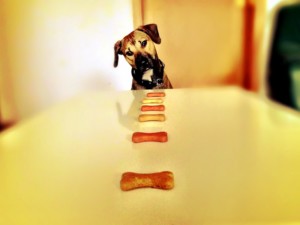We’ve all experienced it—we go to give our dog a treat and instead of taking it gently out of our hands, the dog chomps down on your fingers, as well as the treat. You know that your dog is not really trying to hurt you, he is just excited for the treat! Many of us will just cope with this behavior, teaching ourselves to throw the treat or hold it gingerly and snapping back our hands as soon as we see the dog coming in for the chomp, but this is a behavior that can and should be corrected. Here’s how:

Determine the underlying cause
Just as with every “bad” behavior your dog engages in, there is probably a reason he is not taking that treat gently out of your hand. For most dogs, the cause is fear or frustration. In rare cases, it might aggression. If your dog has previously been gentle with taking toys and treats from you, but is becoming more forceful with his teeth, this is a sign that he is disturbed by something in his environment.
Show your dog a treat, but then close it in your fist
Choose a small treat or a piece of food that you can hide in your fist. Show them the treat and then offer your dog a treat in your closed fist. The dog will know the treat is in your hand and will probably start to nip or paw at your hand to get the treat (you can wear a protective glove during this step to protect your hand). Do not give up the treat until they touch your hand with their tongue, nose or, a soft muzzle.
Reward your dog with the treat and verbal affirmation
When your dog gently touches your hand, asking for the treat, reward him with the treat and the word “yes,” or a pat on the head. You can either drop the treat out of your fist onto the ground or offer it in the flat palm of your hand like you would feed a horse.
Build up trust with your dog
 Continue to offer a food reward in your closed fist until your dog has learned that he will not get that treat by pawing or nipping. Once he has learned this, you can start to transition to holding the treat with your five fingers closed around the item. He will be able to see the treat, but will not be able snatch it away from you. If, in the process of trying to take the treat, he uses his teeth on your fingers, close the treat in your fist until he uses that soft touch to ask for it again. Only let go of the treat when his teeth are not on your skin and he is using a very gentle touch.
Continue to offer a food reward in your closed fist until your dog has learned that he will not get that treat by pawing or nipping. Once he has learned this, you can start to transition to holding the treat with your five fingers closed around the item. He will be able to see the treat, but will not be able snatch it away from you. If, in the process of trying to take the treat, he uses his teeth on your fingers, close the treat in your fist until he uses that soft touch to ask for it again. Only let go of the treat when his teeth are not on your skin and he is using a very gentle touch.
Consider changing your method
If you are not seeing success with the above method, you might need to reverse engineer the process by which you give your dog a toy or treat. Having him sit and then tossing the treat at his feet or in his bowl is a good way to reinforce a non-biting behavior when being given a reward. You will want to teach your dog to sit calmly and wait until he is given verbal confirmation that it is alright to retrieve that treat or toy.




